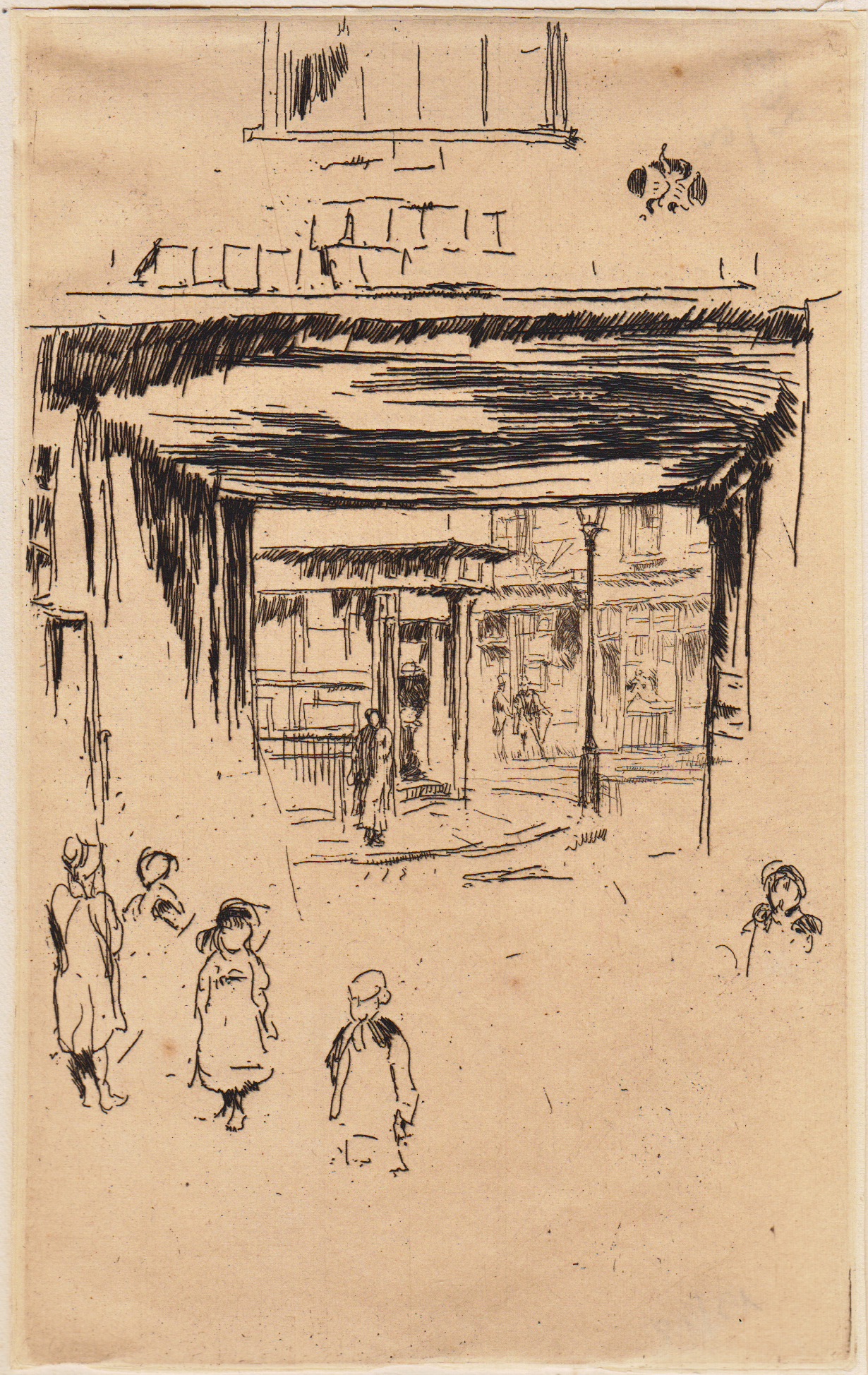
|
|
Drury Lane
Kennedy 237, Mansfield,
234, Glasgow 243
etching ,
1880-1881, a superb impression,
the first (and only) state, cleanly and crisply printed in black with fine uniform plate tone, on
very thin, 18th-century buff laid paper, with thread
margins, some quite localized crimping along
the left and bottom margins, with old hinges on the upper sheet edge,
verso,
otherwise
in excellent
condition
P. 161 x 101 mm., S. 163 x 103 mm.

|
Whistler here again takes up a
rather commonplace subject, one of his most favorite: the doorway/shopfront façade. In England of course, but also in his
travels from Paris, to Brussels, Amsterdam and Venice, he tirelessly explored this basic feature of the
urban landscape with remarkable perspicacity.
This particular street scene is set in London, east of Covent Garden, in Drury
Lane, which has long been associated with the theatre of the same name
and the surrounding entertainment district. Its reputation has
varied greatly over the years* (it is in fact the setting of Hogarth's
celebrated 18th-century etching series, A Harlot's Progress), but in Whistler's time it was rather forlorn. **
The etching style is spare,
sure, and alert, with no added drypoint retouching (only one state
known), with a sense of depth given through the portal resulting from
rather sophisticated biting, the extremely fine lines in the far
background here showing in great detail. In the early 1880s,
Whistler drew the London etchings directly from life: as Katherine
Lochnan notes (in The Etchings of James McNeill Whistler, 1984, p. 223), "He
carried around grounded copper plates and used them as a convenient
surface for the jotting down of visual impressions as if they were
sheets in a sketchbiook."
This print was included in A Set of Twenty-Six Etchings, published by Messrs Dowdeswell and Thibaudeau in 1886, and printed by the artist:
When
Whistler was satisfied with this etching, he sent the copper plates to
the publishers, who arranged for a selection to be printed by Émile
Frédéric Salmon (1840-1913) for Messrs Dowdeswell, including Drury Lane. However, Whistler then decided to print them himself. ***
The cover sheet for this edition mentions:
THIRTY
SETS ONLY WILL BE PRINTED EVERY IMPRESSION WILL BEAR MR. WHISTLER'S
AUTOGRAPH, AND WILL BE MOUNTED ON BOARD, AND ISSUED IN A PORTFOLIO
SPECIALLY DESIGNED BY THE ETCHER...
According to the correspondence between Whistler and Dowdeswell:
There
are numerous dockets, receipts and lists recording the printing and
delivery of the edition. Two impressions of Drury Lane were delivered
on 2 April, ten on 28 July, four on 25 September 1886; nineteen on 15
January 1887, making a total of 35. ***
The plate was subsequently
cancelled. Glasgow cites 26 known impresssions, but it is also
known that impressions of this etching had been exhibited as of 1883, so
it is plausible there may be several more.
At present, it is impossible
to ascertain whether the present impression precedes or accompanies the
first edition, although the clarity of the finest lines in the far
background, as well as the trimming to the edge of the platemark, would
in our opinion support the former.
As it comes from a private
Parisian collection, it may also be that, given a small preliminary
printing of the plates for this edition by Émile Frédéric Salmon in
Paris:
A
few impressions were printed in Paris on a paper chosen by A.W.
Thibaudeau which W[histler] liked. There had been some talk of the
plates being printed in Paris but before the end of the negotiations
with Dowdeswell Whistler decided to print himself . ****
An impression from this first trial printing may thus not be ruled out.
* See Walter Thornbury, 'Drury Lane Theatre', in Old and New London: Volume 3 (London, 1878), pp. 218-227 on the website http://www.british-history.ac.uk/old-new-london/vol3/pp218-227, contemporary to Whistler.
** In 1883, a
critic described this etching as "a curious vista view, seen through a
gateway, of the dirty, dismal, but not unpicturesque-looking houses of
Drury-lane." (Anonymous, 'The Studio. An Arrangement in White and
Yellow', in The Queen, 24 February 1883).
*** Glasgow
catalogue:
http://etchings.arts.gla.ac.uk/catalogue/search/ts_display/index.php?catno=K237&rs=&q=drury+lane&xml=pri
**** Glasgow catalogue: http://etchings.arts.gla.ac.uk/catalogue/sets_texts/?eid=venice2


